View from the basement
Addendum 5: 4-track live recording
4/01 : As with most 4-trackers, the Fostex XR-7 is capable of simultaneous recording on all tracks making it suitable for live taping. Squeezing a whole band on just four tracks is still not an easy task. After many failed attempts this is what I've concluded to be the most fool-proof setup : First you need 4 mic stands, preferrably boom stands. Seems like an idiotic thing to even mention, but I've dangled mics in front of amps before and found it to be a bad idea. Another understatement is that you need 4 good mics. The emphasis here is on good. Beg, borrow and scrounge the best ones you can find, ideally large diaphram types (pretty rare among working musicians). At least something like an EV457, or at the very least SM57s/58s. Anything less will only yield a distorted mess as cheap mics simply can't handle high sound pressure levels over wide frequency ranges. Then of course you need 4 long cables with either matching transformers or XLR to 1/4 inch adapters (which you can build yourself).
For drums use a short stand or a boom, a regular stand will not go low enough. I set the mic about butt-level (the drummer's butt not mine) aimed at the snare just right of the hi-hat (assuming your drummer is right-handed). How far back depends on how close to the wall you have to set up. If the drummer uses the wall for a backrest in between songs then it might be a little close, but if you can get it 2 to 3 foot away from the bass pedal that will get everything in with good emphasis on the bass and snare. I mic the guitar cabinet from a distance of about 12 inches pointed at the speaker's cone and slightly off-center. At 12 inches it probably doesn't matter but it's just habit not pointing a mic at the speaker's dust cover. Same thing with the bass guitar cabinet, but with some mics you might have to back it off to 16 inches or so. Vocals are the real challenge. I've tried many, many times running a line from the mixing board and I have never been totally satisfied with the results. The singer always sounds like he's in a different room than the rest of the band, and the stage bleedover through the vocal mic is impossible to EQ out of the mix. What I do is (using the same 12 inch rule) aim a mic on a boom stand at one of the stage front monitors. This is a little conspicuous and sometimes in everybody's way, but this gives you a vocal track that blends very well with the rest of the mix, and the vocal mic bleedover seems to be washed-out by the natural stage sound bleeding over through the recording mic. What we end up with is four clean, dry tracks that share the same sonic characteristics that can be made to sound however you want it to sound in the final mix with proper compression, effects and EQ. Yes, you'll have bleedover on all the tracks, but you're stuck with that no matter what unless you go to using direct lines, which have never worked well for me in a live situation.
One thing this reminds us about 4-trackers is that they're limited to recording 4-piece bands. In our case the lead singer also plays rhythm guitar. If the
rhythm guitarist plays opposite the lead player, you can set his amp next to the bass cabinet and adjust the mic accordingly. If the bass player plays on the same side as the lead player then
about all you can do is feed some of the rhythm guitar through the monitor and share a track with the vocals. This is hard to EQ, but at least they're both in that mid-range area. If you try to
share the bass guitar with the vocals you'll never get the low end you need without amplifying that "hollow boom" you get from stage noise through the vocal mics that you don't hear through the
PA because it's notched out. If you have a keyboard player this same option applies, and will achieve the same adequate-at-best results. Another option if you don't like the idea of using a
monitor mic is to suspend the mic level with and in triangulation to your PA tops over the dance floor. Great for crowd response on tape but I've found that there's just too much noise coming off
the stage blasting directly into the mic. For my money, the first metod is the most fail-safe. Use the best mics you can get your hands on, use boom stands using the 12 inch rule of thumb, and
avoid direct lines altogether (at least for 4-trackers. If we're talking 8-track or more, recording off the board becomes a whole new ballgame).

USE YOUR BROWSER'S BACK BUTTON TO RETURN :